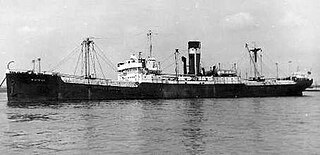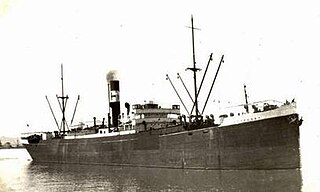
SS Ceramic was an ocean liner built in Belfast for White Star Line in 1912–13 and operated on the Liverpool – Australia route. Ceramic was the largest ship serving the route until P&O introduced RMS Mooltan in 1923.

SS Clan Macwhirter was a British cargo steamship. She was built in 1918 as Ypresville in the First World War and sunk by enemy action in 1942 in the Second World War. In her 24-year career she also carried the names Halizones and Willcasino.
SS Assyrian was a cargo ship that was built in Hamburg for German owners in 1914, transferred to British owners in 1920 as war reparations and sunk by a U-boat in 1940. She was launched as MS Fritz, and when she changed owners in 1920 she was renamed MS Assyrian. She had been built as a motor ship but in 1925 she was converted to a steamship and became SS Assyrian.

SS Blairspey was a steam cargo ship that was built in Scotland in 1929 and served in the Battle of the Atlantic in the Second World War. In 1940 she survived being part of Convoy SC 7 and managed to reach port, despite being hit by at least three torpedoes from two different U-boats. The ship was rebuilt with a new bow and renamed Empire Spey 1942. Her original name was restored in 1946. She was renamed Evandros 1961 and scrapped in Italy in 1967.
SS Beatus was a British cargo steamship that was built in 1925, sailed in a number of transatlantic convoys in 1940 and was sunk by a U-boat that October.

SS Somersby was a British cargo steamship that was built in 1930, sailed in a number of convoys in the Second World War and was sunk by a U-boat in 1941.

SS Fiscus was a UK cargo steamship that was built in 1928, served in the Second World War and was sunk by a U-boat in 1940.

SS Scoresby was a British cargo steamship that was built in 1923, sailed in a number of transatlantic convoys in 1940, and was sunk by a U-boat that October.
SS Tregenna was a cargo steamship that was launched in England in 1919 and sunk by a U-boat in the Battle of the Atlantic in 1940 with the loss of 33 of her 37 crew. She was laid down as War Bulldog, but the Hain Steam Ship Co bought her before she was completed and renamed her Tregenna.

SS Hilary was a British steam passenger liner that was built in 1931 and scrapped in 1959. She spent much of her career on a scheduled service between Liverpool in England and Manaus in Brazil.

SS Oropesa was a British steam turbine ocean liner of the Pacific Steam Navigation Company (PSNC). She was built on Merseyside in 1920 and operated between Liverpool and South America. In 1941 the German submarine U-96 sank her in the Western Approaches, killing 106 people aboard.
SS Clan Macarthur was a British refrigerated cargo steamship. She was built for Cayzer, Irvine and Company's Clan Line Steamers Ltd as one of its Cameron-class steamships. She was launched in Greenock in 1936 and sunk in the Indian Ocean by enemy action in August 1943.
SS Umona was a British cargo liner. She was built at Sunderland on the River Wear in 1910, survived the First World War and was sunk by enemy action off Sierra Leone, West Africa in 1941.
SS Llanashe was a UK cargo steamship. She was launched in 1936 in Sunderland, England, and sunk by a U-boat in the Indian Ocean in February 1943.
SS Nailsea Court was a UK cargo steamship. She was launched in 1936 in Sunderland, England. She was named after Nailsea Court in Somerset, England, which is an historic Elizabethan manor house. A U-boat sank her in the North Atlantic in March 1943. 45 men died and only four survived.
MV Seaforth was an Elder Dempster Lines cargo motor ship that traded between Liverpool and West Africa. She was launched in 1938 in Scotland and sunk in 1941 in the North Atlantic.
SS Jumna was a steam passenger liner that was built in Scotland in 1929 and sunk with all hands by a German cruiser on Christmas Day 1940. She was a ship in the fleet of James Nourse, Ltd, whose trade included taking indentured labourers from India to the British West Indies.
SS Tregarthen was a cargo steamship that was built in Scotland for the Hain Steam Ship Co in 1936. She was sunk with all hands by a U-boat in 1941 in the Battle of the Atlantic.
SS Hartlebury was a cargo steamship that was launched in Scotland in 1934 for J&C Harrison Ltd. A U-boat sank her in the Barents Sea in 1942 when Hartlebury was a member of the Arctic convoy Convoy PQ 17.
SS Algarve was a Danish cargo steamship that was built in 1921 for DFDS. After Germany invaded Denmark in April 1940 Algarve was transferred to the UK Ministry of War Transport. In 1941 an E-boat sank her with all hands in the North Sea.








